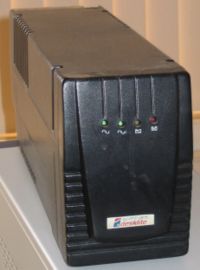
Photo from wikipedia
In this paper, we have shown a DC-DC buck converter design, using two supercapacitors only as power sources. This design eliminates the use of a battery. Here one supercapacitor supplies… Click to show full abstract
In this paper, we have shown a DC-DC buck converter design, using two supercapacitors only as power sources. This design eliminates the use of a battery. Here one supercapacitor supplies the positive and the other one supply the negative voltages for powering up all the converter components and for the PWM circuit. The PWM generates a duty cycle, which changes with time to keep the output voltage constant. This output voltage changes due to the continuous voltage drop of supercapacitors modules and due to the output load fluctuation. Therefore, we had in place both feedforward and feedback loop for the control circuit. The strategy for the generation of PWM was to maintain the reference voltage constant throughout the time of operation. On the other hand, the triangular peak maximum voltage was made to follow the voltage decay curve of the supercapacitor modules. This circuit is designed to extract an equal amount of power from both the supercapacitor modules. Thus, the voltages decay at the same rate for both modules. The output current and output voltage for this circuit we have designed is for handheld devices, like mobile phones and the operating frequencies were ranging from 100–120KHz.
Journal Title: IEEE Access
Year Published: 2021
Link to full text (if available)
Share on Social Media: Sign Up to like & get
recommendations!